Overview
Understanding and managing uterus belly fat involves recognizing its connection to factors like uterine fibroids and postpartum changes, which can lead to hormonal imbalances and weight gain. The article emphasizes that a holistic approach combining healthy eating, regular exercise, and stress management is essential for effectively addressing these issues and improving overall well-being.
Introduction
In the pursuit of holistic well-being, understanding the intricate connections between physical health, mental resilience, and lifestyle choices is essential. From the impact of uterine fibroids on weight gain to the challenges of postpartum body changes, women face unique hurdles that require attention and action.
By prioritizing healthy eating habits, establishing consistent exercise routines, and emphasizing mental health, individuals can reclaim their vitality and confidence.
This article delves into these critical aspects, offering insights and strategies that not only empower women but also foster a supportive environment in workplaces.
Embracing these practices can lead to transformative outcomes, enhancing overall health and well-being for both individuals and their teams.
The Connection Between Uterine Fibroids and Weight Gain
Uterine fibroids are non-cancerous growths in the uterus that can result in a variety of symptoms, including considerable gain in mass. Recent studies indicate that these growths can disrupt hormone levels, particularly estrogen, leading to an increase in uterus belly fat, especially in the abdominal region. Significantly, the multivariate incidence rate ratios (IRRs) for women with differing BMIs emphasize the effect of fibroids on gain:
- Women with BMIs of 20.0-22.4 kg/m had an IRR of 1.34
- Women with BMIs of 22.5-24.9 kg/m had an IRR of 1.39
- Women with BMIs of 25.0-27.4 kg/m had an IRR of 1.45
- Women with BMIs of 27.5-29.9 kg/m had an IRR of 1.47
- Women with BMIs of 30.0-32.4 kg/m had an IRR of 1.36
- Women with BMIs of 32.5+ kg/m had an IRR of 1.21
Women affected by fibroids often notice changes in their waistline, which are linked to bloating or the accumulation of uterus belly fat. It is essential for those experiencing these symptoms to engage with healthcare providers who can offer tailored treatment options. Emerging treatments, such as radiofrequency ablation and anti-hormonal drugs, are becoming available, although they may not yet be widely accessible or covered by insurance.
A comprehensive approach that incorporates a balanced diet, regular physical exercise, and effective stress management techniques is vital in alleviating the uterus belly fat that can be associated with fibroids. Furthermore, a study highlighted the limitations in data collection on uterine fibroids, particularly in African countries, which may lead to an underestimation of the true burden and affect health policy and resource allocation in low SDI countries. As Zheng Lou points out,
Raising awareness of uterine fibroids, increasing medical investment, and improving levels of medical care are necessary to reduce future burden.
By prioritizing these strategies, HR Benefits Managers can play a pivotal role in fostering a healthier environment for their teams.
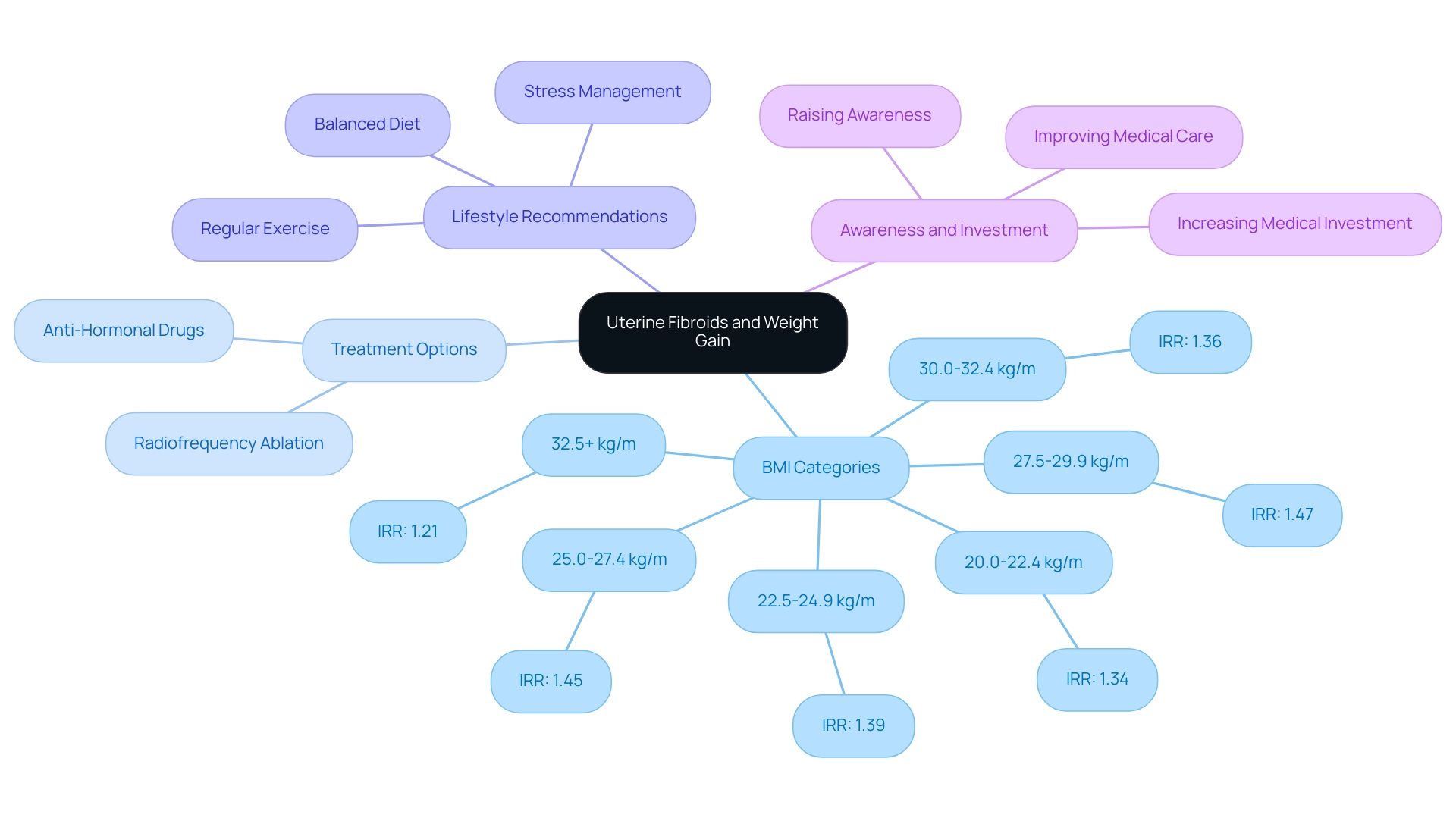
Managing Postpartum Belly Changes: Understanding the 'Mom Pooch'
The term 'mom pooch' refers to the residual uterus belly fat that many women encounter after childbirth, influenced by multiple factors such as hormonal shifts, weakened abdominal muscles, and the physical transformations that accompany pregnancy. Recent statistics indicate that a significant percentage of new mothers experience postpartum uterus belly fat, underscoring the importance of understanding these changes for effective management strategies. New mothers can regain their body confidence by concentrating on a holistic approach that includes:
- Nutritious eating
- Gentle exercises
- Core-strengthening practices
Postnatal yoga and Pilates stand out as particularly effective practices; they not only enhance muscle tone but also foster relaxation and mental well-being. As Sergi noted, the ECW/ICW ratio increased in obese women after weight loss induced by gastric banding, highlighting the complexities of body composition changes during postpartum recovery. Creating a routine that combines physical exercise with instances of self-care can greatly enhance overall well-being and confidence during this transformative period.
As noted in recent studies, engaging in such activities can lead to better wellness outcomes and empower women in their postpartum journey. Furthermore, understanding the factors influencing postpartum mass retention, as illustrated in a recent statistical analysis study, is crucial for developing effective strategies. Remember, prioritizing these practices not only supports individual well-being but also sets a powerful example for health and wellness in the workplace.
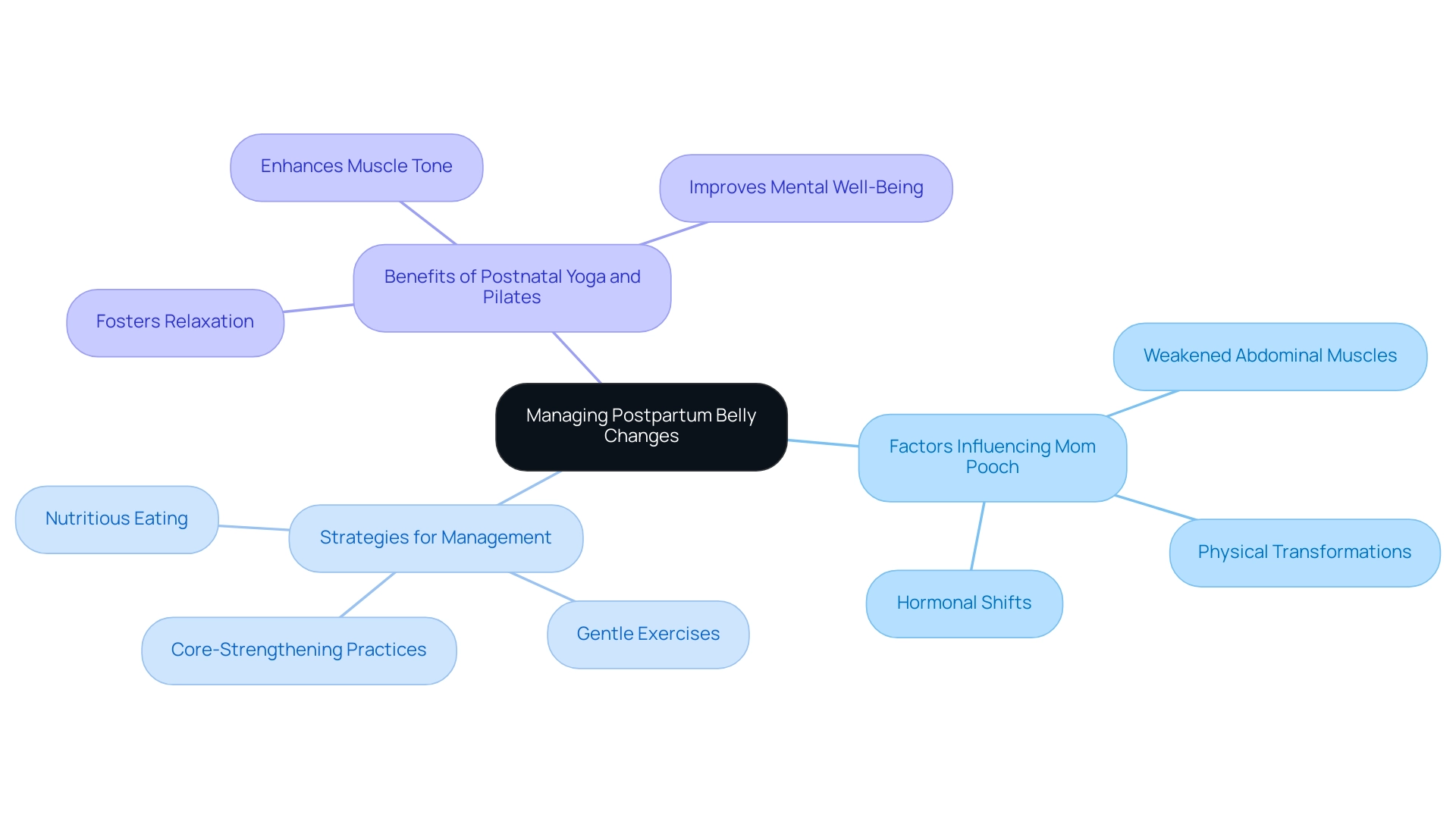
Incorporating Healthy Eating Habits
Adopting healthy eating habits is essential for effectively managing uterus belly fat. A balanced diet that emphasizes whole foods—including a variety of fruits, vegetables, whole grains, lean proteins, and healthy fats—should be your focus. Reducing the intake of processed foods, sugars, and high-fat snacks is crucial, as these contribute significantly to increased body mass.
Notably, increased intake of certain food groups is associated with weight loss, underscoring the importance of dietary choices. Meal prepping stands out as an effective strategy to maintain your dietary goals, enabling you to plan and prepare nutritious meals ahead of time. Interacting with a nutritionist can also offer customized guidance and develop a personalized eating plan that aligns with your wellness goals.
Such guidance ensures that healthy eating becomes both enjoyable and sustainable. Additionally, as 25% of Americans would consider or have done laser fat removal to achieve their 'perfect' body, it highlights the societal pressures surrounding body image and the importance of healthy habits. Remember, with obesity contributing to an estimated $149 billion in annual healthcare costs, prioritizing nutrition not only enhances personal well-being but also contributes positively to overall wellness outcomes.
Moreover, recent research on medium-chain triglycerides (MCTs) indicates their role in enhancing fat metabolism during exercise, making them a valuable addition to your diet. Embrace meal prepping as a key tool in your journey towards reducing uterus belly fat and achieving your ideal health.
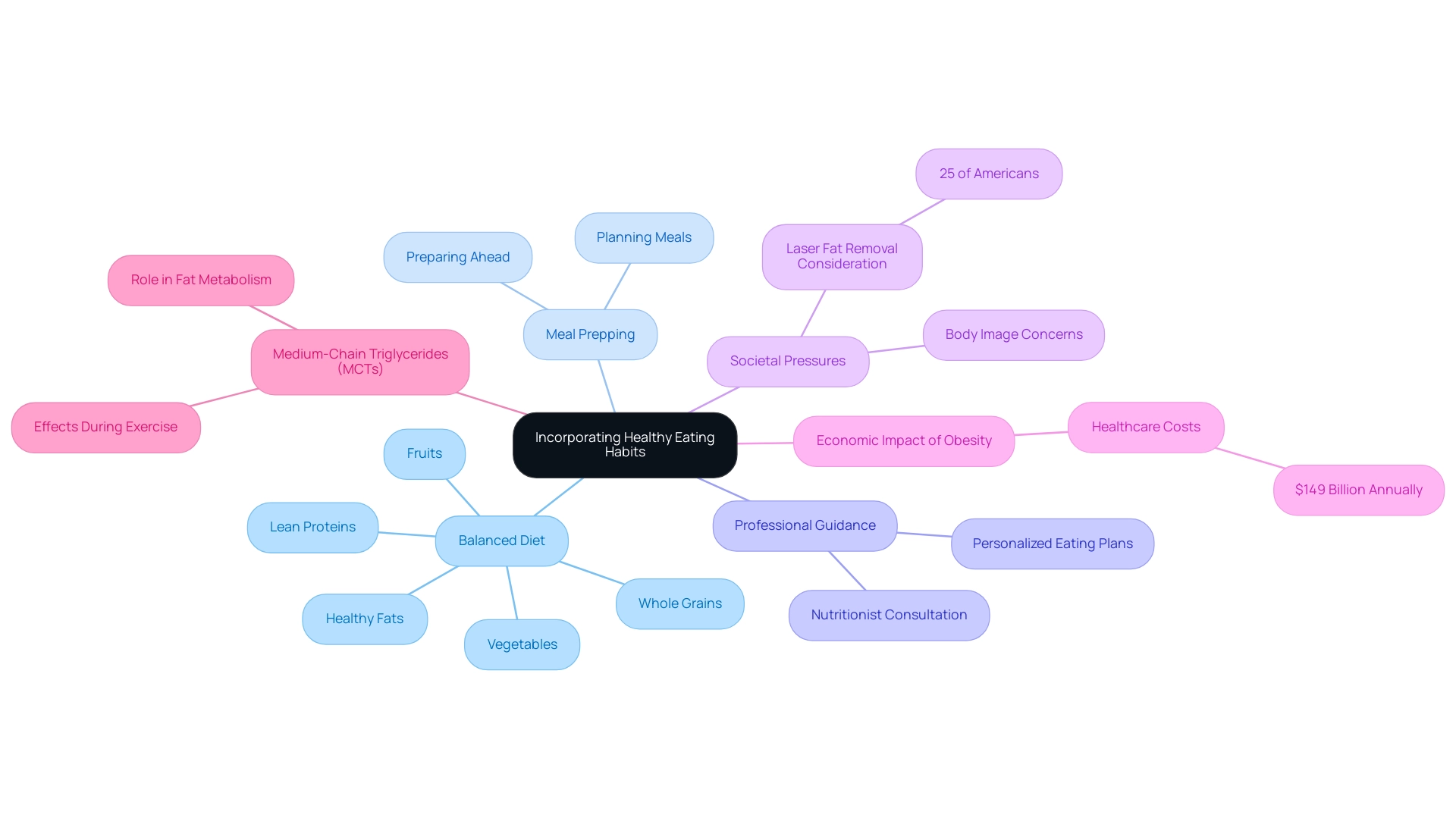
Developing a Consistent Exercise Routine
To cultivate a sustainable exercise routine, begin by establishing realistic goals that harmonize with your lifestyle. Aim for a minimum of 150 minutes of moderate aerobic exercise each week, supplemented by strength training sessions on at least two occasions. Engaging in enjoyable activities such as walking, swimming, or cycling can make staying active feel less like a chore and more like a rewarding experience.
Notably, recent studies show that sprint interval training helps people lose 39.95% more body fat than HIIT while requiring 60.84% less time spent exercising, making it an efficient option for weight management. Additionally, integrating core-strengthening exercises not only targets the abdomen but also enhances overall functional strength. Consider joining a local fitness class or partnering with an exercise buddy, as these social elements can significantly boost motivation and accountability.
To support your efforts, explore our Essential Coaching Plan for just $67/month, offering affordable curated workout programs tailored for diverse fitness goals such as:
- Muscle Gain
- Weight Loss
- Endurance
- Overall Fitness
And experience levels from Beginner to Advanced. With the added advantage of a free 7-day trial for our coaching app, you can experience the transformative power of personalized guidance and streamline your wellness journey. As fitness expert Nick Rizzo states, 'We are happy to give interviews on this topic and related topics at any time,' emphasizing the importance of seeking expert guidance.
Remember, consistency is paramount; by selecting pursuits you genuinely enjoy, you can seamlessly weave exercise into your daily routine and promote a healthier lifestyle for yourself and your team. Sign up today to start your journey!
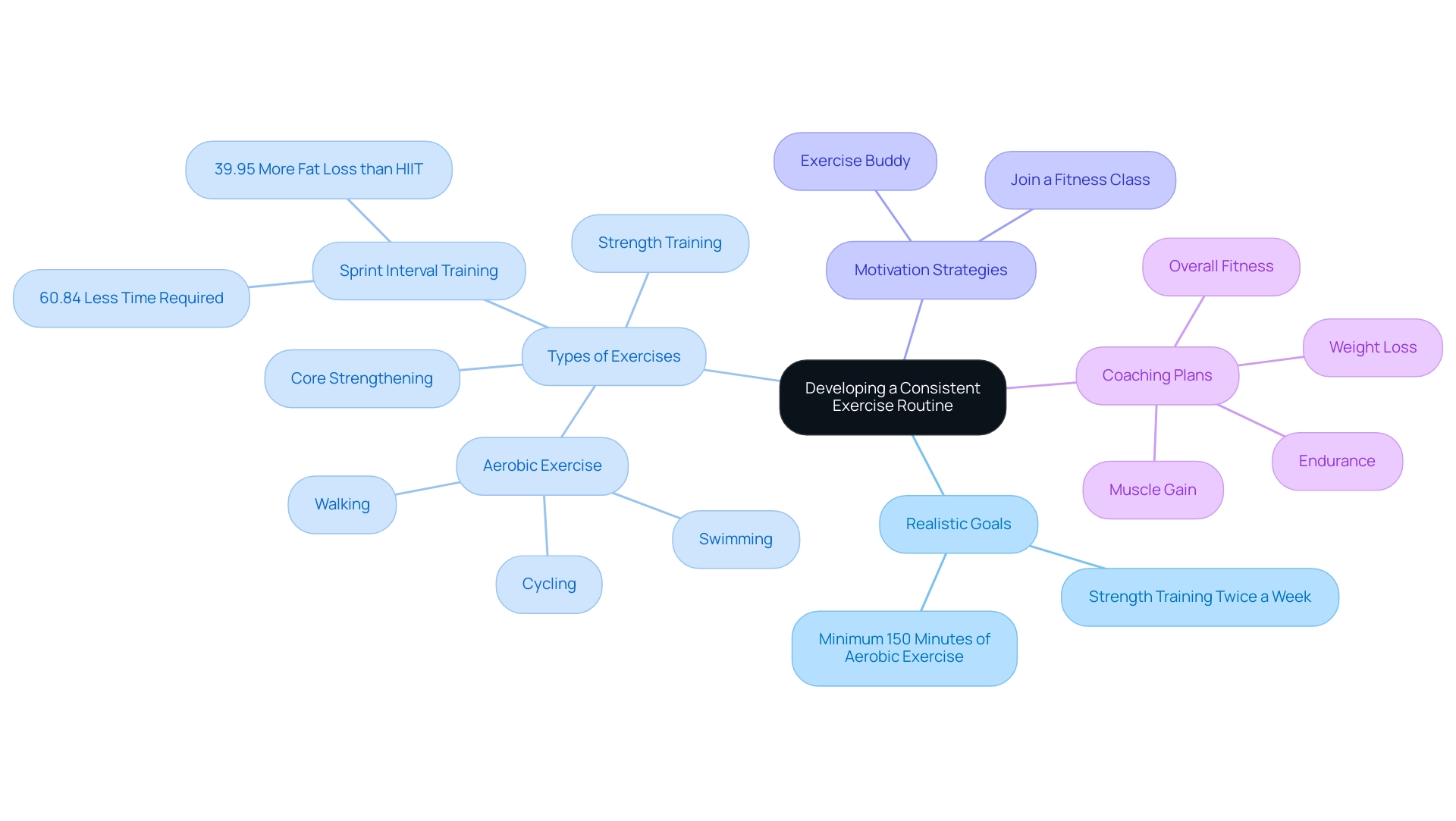
Prioritizing Mental Health and Stress Management
Emphasizing mental health and effective stress management is paramount for achieving overall wellness, directly impacting physical health as well. Evidence shows that engaging in self-care activities—whether through mindfulness, meditation, or deep-breathing exercises—can significantly mitigate stress levels. Additionally, incorporating regular exercise into self-care routines is crucial.
Research from the journal 'Preventive Medicine' suggests that employees who participate in physical exercise, such as a daily 30-minute walk, report higher levels of motivation and lower stress, ultimately enhancing workplace performance. Furthermore, findings from 'Workplace Health & Safety' reveal that employees who participate in workplace exercise programs experience a reduction in absenteeism and presenteeism, leading to increased engagement at work. Establishing a self-care routine filled with enjoyable activities, such as:
- Reading
- Gardening
- Connecting with loved ones
can provide a much-needed respite from daily challenges.
Furthermore, reaching out for support through counseling or joining support groups can uncover valuable insights and coping mechanisms. As observed by D. Lichtermann, the occurrence of cancer among individuals with schizophrenia highlights the urgent necessity to tackle mental well-being comprehensively. The case study titled 'Access to Care for People with Mental Illness' reveals that individuals with serious mental illnesses face numerous barriers to accessing primary medical services, including stigma and poverty, which can exacerbate their conditions.
This highlights the importance of incorporating mental well-being support into wellness initiatives. Remember, nurturing your mental well-being is just as crucial as maintaining physical health in your journey toward comprehensive wellness, and regular exercise plays a key role in this balance.
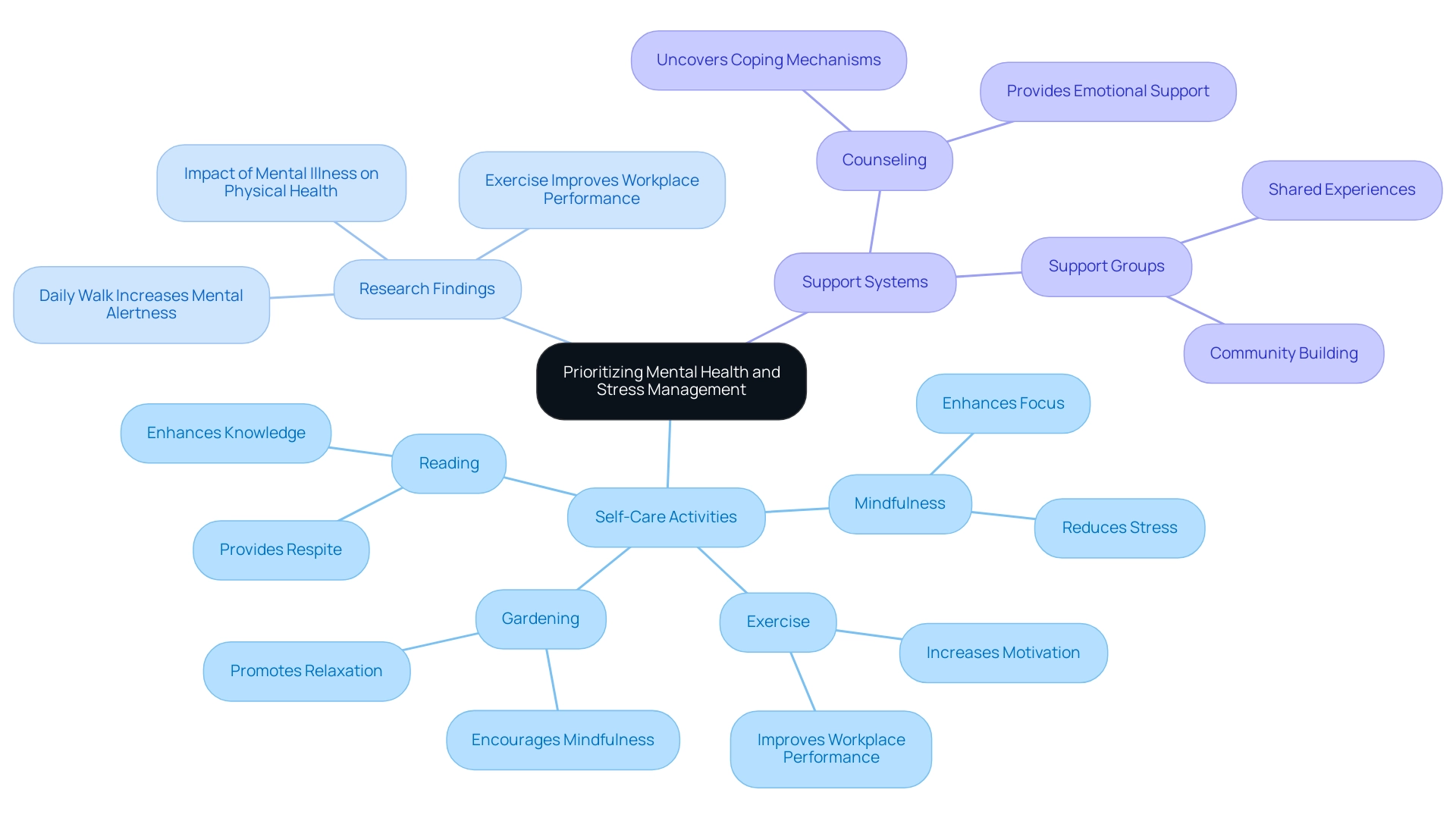
Conclusion
Recognizing the connections between physical health, mental resilience, and lifestyle choices is essential for women facing challenges such as uterine fibroids and postpartum body changes. By understanding these interactions, individuals can take proactive steps to enhance their well-being. Addressing the effects of uterine fibroids on weight gain underscores the importance of tailored healthcare and lifestyle modifications, including balanced nutrition and regular exercise.
For new mothers, managing postpartum changes involves a holistic approach that promotes body confidence and overall health. Embracing nutritious eating habits and engaging in enjoyable physical activities can help reclaim vitality and set a positive example for others. Strategies like meal prepping and consulting with nutritionists support informed dietary choices that enhance long-term wellness.
Establishing a consistent exercise routine not only aids in weight management but also fosters community and motivation. By integrating enjoyable activities and creating supportive environments, individuals can cultivate sustainable habits that benefit personal health and workplace culture. Additionally, prioritizing mental health and stress management is crucial for overall wellness. Self-care practices and a supportive atmosphere can enhance employee engagement and productivity.
In summary, focusing on the interconnected aspects of physical and mental health leads to transformative outcomes. By championing initiatives that support healthy choices, organizations can empower their teams to thrive, resulting in improved well-being and productivity. Now is the time to take action and cultivate a culture of wellness that uplifts individuals and strengthens workplace dynamics.




